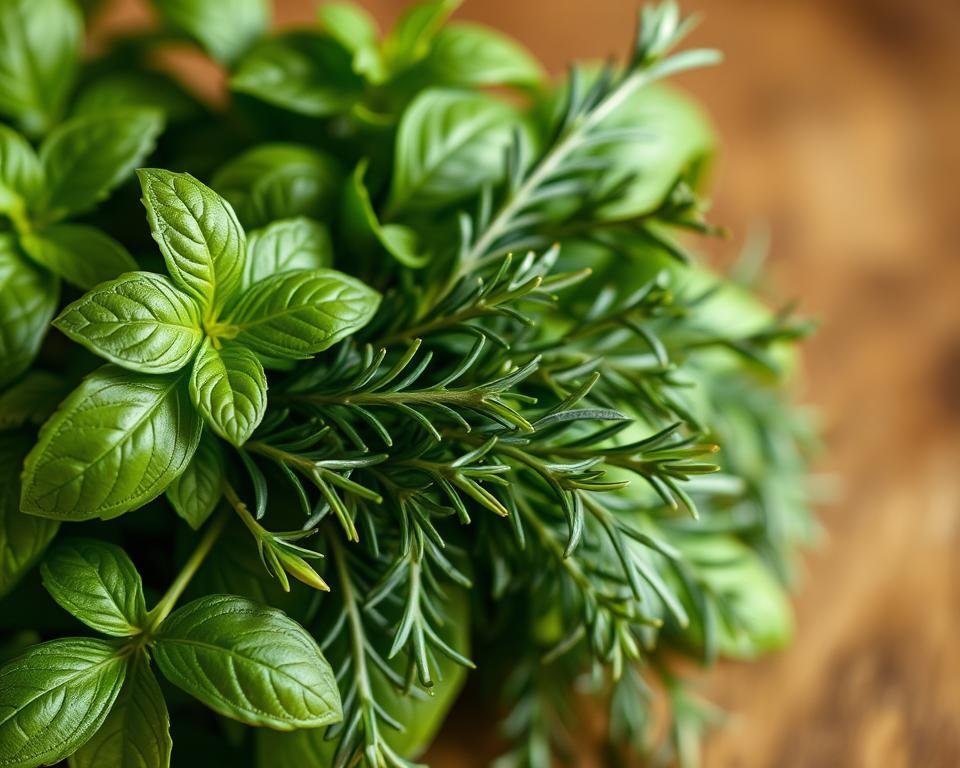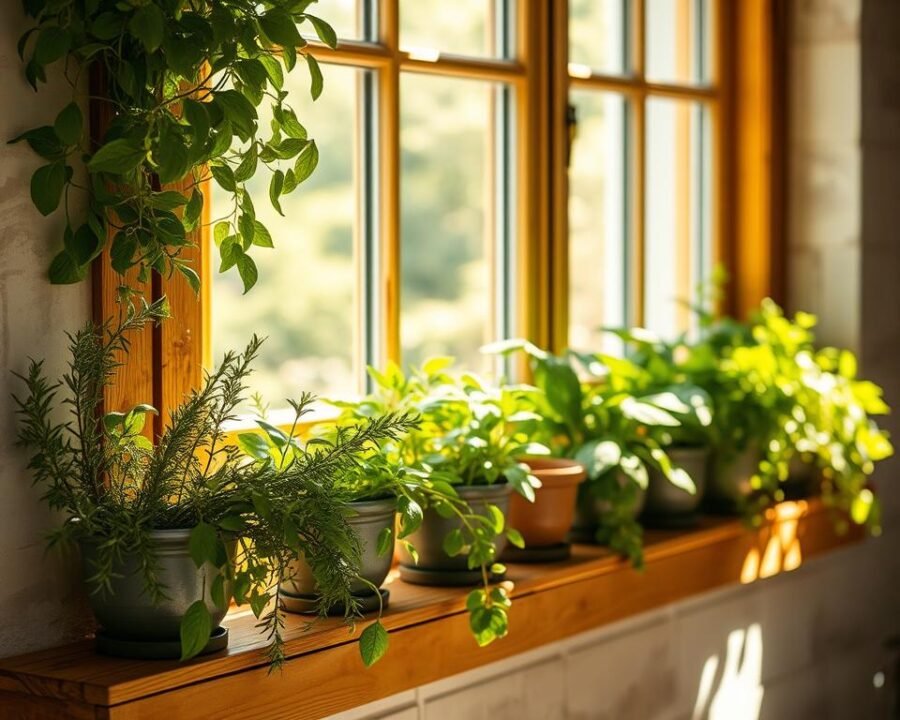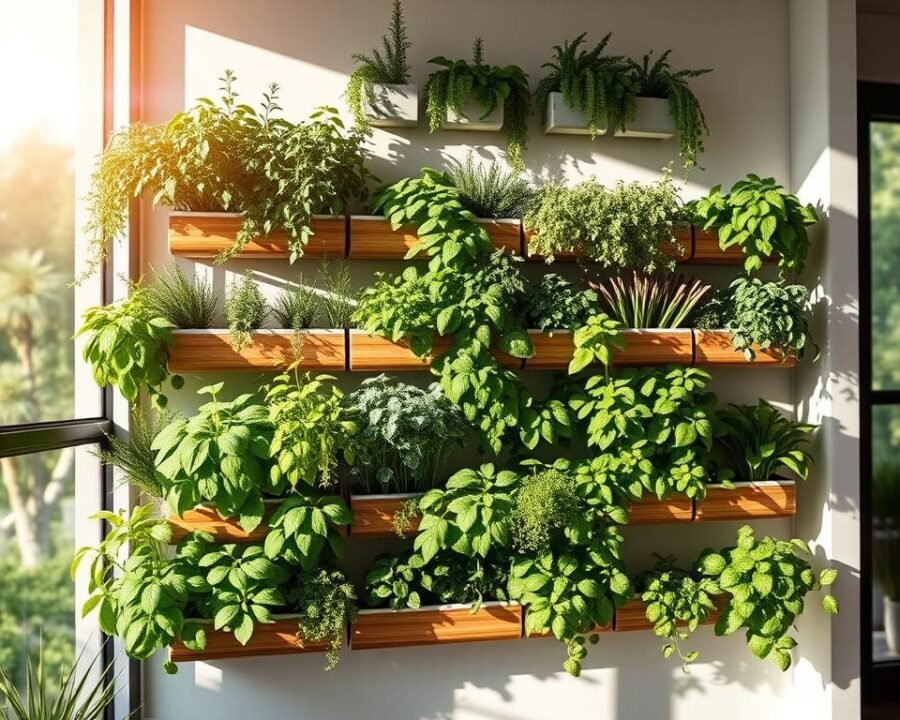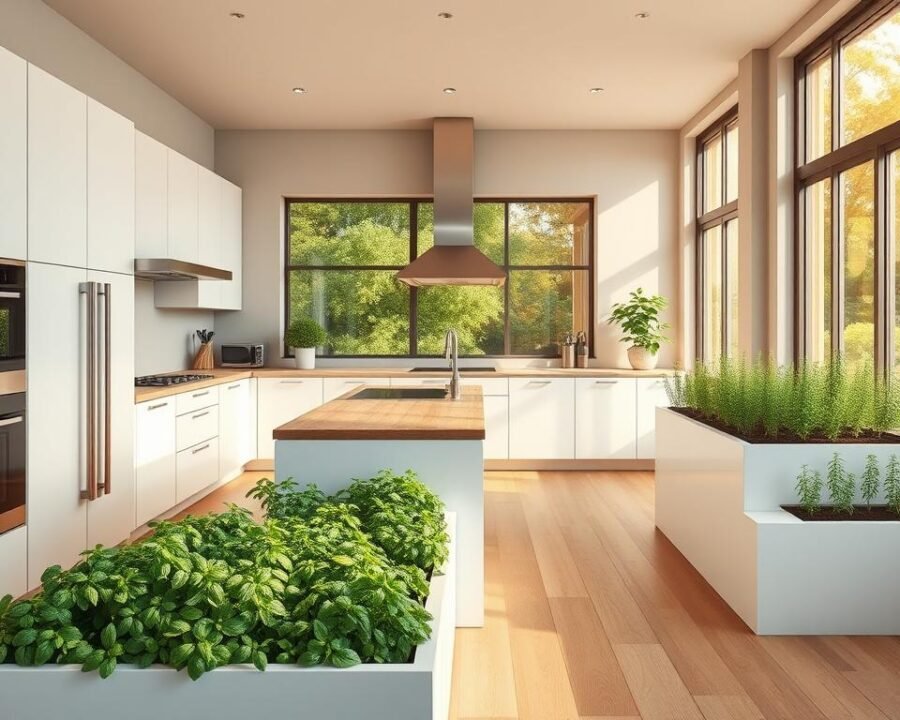Our Picks for Best Kitchen with Herb Garden You Need to Try
Imagine stepping into a space where the aroma of fresh herbs greets you every morning. No more last-minute grocery runs—just pluck what you need right from your countertop. A small herb garden transforms meals, adds life to your kitchen, and sparks joy in daily routines.
Whether you live in a cozy apartment or a spacious home, growing herbs is easier than ever. From sleek hydroponic setups to rustic wooden planters, there’s a design for every style. We’ve curated 37+ innovative ideas to inspire your next project.
Urban dwellers and home chefs alike can enjoy fresh flavors year-round. These setups blend functionality with aesthetics, turning even the smallest corners into vibrant green spaces. Ready to explore magnetic fridge jars, vertical planters, or integrated countertop systems? Let’s dive in.
Key Takeaways
- Modern herb gardens enhance flavor and elevate kitchen aesthetics.
- Options range from compact window sill planters to advanced hydroponics.
- Fresh herbs are easily accessible, reducing grocery trips.
- Designs suit urban spaces and larger homes alike.
- Featured ideas include magnetic jars and vertical growing systems.
Why a Kitchen Herb Garden is a Must-Have
Nothing beats the instant burst of flavor from freshly picked leaves in your meals. A small herb garden bridges the gap between farm and table, ensuring peak freshness for every dish.
Fresh Flavors at Your Fingertips
Basil’s sweet punch elevates pasta sauces, while rosemary transforms roasted meats. With aromatic herbs steps away, last-minute garnishes become effortless. Think chive blossoms on salads or thyme sprigs in soups—nature’s instant flavor boosters.
Enhances Your Space’s Aesthetic
Beyond taste, greenery adds life to any room. Apothecary jars filled with mint or cascading planters turn functional grows into art. Studies show living plants reduce stress, making your herb garden a wellness tool too.
Boosts Culinary Creativity
87% of home chefs experiment more with accessible herbs. Try frying sage for crispy toppings or blending cilantro into zesty chimichurri. When ingredients are this fresh, every meal feels inspired.
From psychological perks to dishes that dazzle, a herb garden redefines cooking. It’s not just about convenience—it’s a lifestyle upgrade.
Best Herbs to Grow in Your Kitchen
Transform cooking routines by growing essential flavors indoors. These four herbs deliver bold taste, easy care, and endless culinary inspiration. Let’s explore their unique perks.

Basil: The Versatile Superstar
With 15+ varieties, basil adapts to any dish. Sweet Genovese elevates pesto, while Thai basil spices up stir-fries. It thrives with 6 hours of sunlight and pairs perfectly with tomatoes—plant them together for mutual benefits.
Rosemary: Robust and Low-Maintenance
Rosemary’s woody stems and pine-like aroma withstand neglect. Water every 10–14 days, and it’ll reward you with intense flavor for roasted meats or bread. Slow-growing but long-lasting, it’s a hardy staple.
Mint: Fast-Growing and Refreshing
Mint grows explosively—up to 3 inches weekly. Keep it contained in pots to avoid overtaking other plants. Its bright leaves shine in teas, salads, or mojitos. For space efficiency, try Inspired by Charm’s chicken feeder planter hack.
Cilantro: A Polarizing but Vibrant Choice
Love it or hate it, cilantro sparks debate. 23% of people detect a soapy taste due to genetics. Substitute culantro for a similar but milder profile. Its citrusy punch is unmatched in salsas or Asian dishes.
Preserve excess harvests by freezing herb cubes or drying bundles. Whether it’s oregano’s Mediterranean intensity or parsley’s fresh finish, these herbs redefine convenience and flavor in every meal.
Best Kitchen with Herb Garden You Need to Try: Top Designs
Brighten your culinary space with these clever designs that merge greenery and functionality. From sunny ledges to vertical setups, each option caters to different needs and aesthetics. Let’s explore three standout styles.

Classic Window Sill Planters
Sunlit ledges are prime real estate for thriving greens. South-facing windows offer 6+ hours of light, perfect for basil or thyme. Terracotta pots add rustic charm but dry out faster—self-watering resin planters are a low-maintenance alternative.
For small-scale irrigation, Houseful of Handmade’s drip system keeps soil evenly moist. Pro tip: Group herbs with similar light needs (e.g., rosemary and sage) for easier care.
Hanging Herb Baskets for Small Spaces
No counter room? No problem. Hanging herb baskets utilize vertical areas, like above sinks or islands. Etsy’s $43 wooden frame planter holds up to 15 lbs—ideal for lightweight mint or cilantro.
Somewhat Simple’s painted tin cans add a DIY touch. Ensure brackets are anchored securely, especially for heavier ceramic planters.
Magnetic Herb Jars on the Fridge
Fuloar’s $24 magnetic herb garden sticks to appliances, keeping flavors within reach. Rare earth magnets securely hold stainless steel jars—no slipping, even when loaded with parsley or chives.
Garden Therapy’s detachable mason jars simplify harvesting. Just snap off a jar, snip leaves, and reattach. Perfect for renters or those craving flexibility.
| Planter Type | Pros | Cons |
|---|---|---|
| Terracotta | Breathable, classic look | Requires frequent watering |
| Self-Watering Resin | Low upkeep, modern finish | Higher initial cost |
Whether you prefer the charm of windowsill greens or the innovation of magnetic herb kits, these designs blend form and function. Start small, then expand as your confidence grows.
Space-Saving Herb Garden Ideas
Small spaces demand big creativity—here’s how to grow herbs vertically. Whether you’re tight on counter space or crave a minimalist look, these designs blend functionality with style. Let’s explore three game-changing setups.

Vertical Wall Planters
Blank walls become edible art with vertical wall planters. Home Made by Carmona’s $10 tutorial uses reclaimed wood for rustic charm. Measure at least 12″ between shelves for herb growth.
For low-light areas, parsley and chives thrive. Compare tension rods (rental-friendly) vs. permanent mounts (sturdier). The Craft Patch’s cedar fence design adds texture while maximizing space.
Floating Shelf Displays
Floating shelf displays turn herbs into living decor. Inspired by Charm repurposes file organizers into sleek planters. Use Proper’s clay markers to label basil or mint for a polished touch.
Group herbs by water needs—succulents like rosemary on top, thirstier mint below. This way, care becomes effortless.
Over-the-Sink Extendable Shelves
Utilize unused airspace with expandable shelves above sinks. Lovely Indeed’s lotion bottle hack creates self-draining pots—drill holes in lids for excess water flow.
Choose compact herbs like thyme or oregano. These garden ideas prove even the tiniest kitchens can flourish with greenery.
DIY Herb Garden Projects
Turn everyday containers into thriving green spaces with these clever DIY projects. No fancy tools needed—just creativity and a love for fresh flavors. We’ll explore three budget-friendly ideas to spark your next weekend project.
Mason Jar Herb Gardens
Mason jars add rustic charm to any space. Modify them for drainage by drilling 3-4 holes in the bottom. Layer pebbles at the base to prevent root rot.
Pair jars with Proper’s *scalloped clay markers* for a polished look. Group them on a vintage ladder (Tierney McAfee’s display idea) for vertical impact.
Upcycled Wine Crate Planters
Source wooden crates from local wineries or craft stores. Line them with landscape fabric to retain soil. Garden Therapy’s guide suggests spacing herbs 6″ apart for growth.
Chalkboard labels offer flexibility, while vinyl lasts longer outdoors. Compare both in our table:
| Label Type | Pros | Cons |
|---|---|---|
| Chalkboard | Editable, rustic vibe | Requires upkeep |
| Vinyl | Weatherproof, sleek | Permanent |
Repurposed Tin Can Herb Holders
Somewhat Simple’s painted tin cans add pops of color. Sand sharp edges and punch drainage holes. BuiltWithMyBareHands’ Etsy designs use geometric patterns for modern flair.
For safety, wear gloves when handling cut metal. These planters thrive on sunny windowsills or hanging rails.
Tech-Savvy Herb Garden Solutions
Modern technology meets greenery with these smart herb-growing innovations. Whether you’re a busy home chef or a tech enthusiast, these tools simplify cultivation while maximizing flavor. Let’s explore three cutting-edge systems.
Countertop Hydroponic Systems
AeroGarden’s 3-pod starter kit eliminates soil mess with hydroponic precision. Its built-in LED panel mimics sunlight, while liquid nutrients boost growth rates by 30% versus soil. Pro tip: Opt for liquid solutions over tablets—they’re easier to adjust for plant needs.
LED Grow Light Setups
Roleadro’s full-spectrum panel delivers energy-efficient light for basil or mint. LEDs use 50% less power than fluorescents and last 3x longer. Set programmable timers to 15 hours daily—the sweet spot for photosynthesis without overheating.
“Smart sensors now alert you when water or light levels dip, taking the guesswork out of care.”
Self-Watering Planters
Lechuza’s planter uses capillary action to wick moisture as needed. Its reservoir holds a 2-week supply, perfect for vacations. Pair with a soil moisture sensor to prevent overwatering—a common rookie mistake.
- Compare: Liquid nutrients offer flexibility; tablets provide convenience.
- Energy savings: LEDs cost $10/year to run vs. $25 for fluorescents.
- Algae prevention: Use opaque reservoirs and change water weekly.
From app-connected gardens to space-saving designs, these herb garden ideas blend innovation with practicality. Embrace tech to grow smarter, not harder.
Stylish Herb Garden Displays
Elevate your space with greenery that doubles as a flavor powerhouse. These designs transform functional plants into conversation-starting decor. Whether you’re a green thumb novice or expert, there’s a display to match your aesthetic.
Apothecary Jar Gardens
Glass jars create miniature greenhouses for delicate herbs. Garden Therapy’s design uses 1-gallon jars maximum—ideal for root space without overcrowding. The sealed environment boosts humidity for moisture-loving mint or basil.
Arrange varying heights for visual interest. Proper’s vintage ladder display showcases jars at different levels. For drainage, add pebbles beneath soil and open lids occasionally.
Herb Spiral Stands
Spiral designs maximize planting space in compact footprints. Clockwise patterns suit right-handed harvesters, while counter-clockwise benefits lefties. Home Made by Carmona’s stacked system uses reclaimed wood for rustic charm.
Position sun-loving rosemary at the top. Place shade-tolerant parsley at the base. This herb spiral creates microclimates in one structure.
Living Wall Art
Vertical gardens turn blank walls into edible masterpieces. The Craft Patch’s picket fence design incorporates air plants between herbs for texture contrast. Powder-coated steel frames outlast wood in humid areas.
For drama, install LED spotlights above. Shadows from leaves create moving art as sunlight shifts. These living wall installations prove functionality can be breathtaking.
- Frame materials: Reclaimed wood (warmth) vs steel (durability)
- Lighting tricks: Uplighting emphasizes texture, backlighting highlights leaf veins
- Plant pairings: Combine thyme’s fine foliage with chives’ vertical lines
Maintaining Your Kitchen Herb Garden
Healthy herbs start with the right balance of water, light, and care. A few simple habits keep plants lush and productive. Let’s break down the essentials for thriving greens.
Watering Tips for Lush Growth
Overwatering is the top killer of indoor herbs. *Make sure* containers have drainage holes to prevent root rot. A drip watering system delivers consistent moisture without guesswork.
Basil needs 1″ of water weekly, while rosemary prefers drier soil. Check moisture by sticking a finger 1″ deep—water only if dry. Group herbs with similar needs to simplify care.
Sunlight: The Energy Source
Most herbs crave 6+ hours of daily sunlight. South-facing windows are ideal, but east-facing ones work for shade-tolerant parsley. Rotate pots weekly to ensure even growth.
Supplement with LED grow lights if natural light is scarce. Position them 12″ above plants for 12–15 hours daily. This mimics outdoor conditions for healthy herbs.
Pruning and Harvesting Like a Pro
Regular pruning encourages bushier growth. Use clean scissors to snip just above leaf nodes. Mint grows rapidly—harvest daily during peak season to control spread.
For woody herbs like rosemary, avoid cutting more than ⅓ of the plant at once. Tender herbs like cilantro can be cut back to 2″ from the soil. Always leave enough foliage for photosynthesis.
| Fertilizer Type | Pros | Cons |
|---|---|---|
| Organic (compost tea) | Gentle, improves soil | Slower results |
| Synthetic (liquid NPK) | Fast-acting | Risk of overuse |
Watch for pests like spider mites—wipe leaves with neem oil weekly. Perennials like thyme benefit from overwintering in a cool, bright spot. With these tips, even new green thumbs can cultivate success.
Conclusion
Fresh flavors and vibrant greens are just steps away with these innovative setups. Whether it’s a vertical planter or magnetic jars, these garden ideas blend style and function seamlessly.
Start small with a 3-herb kit—basil, mint, and parsley thrive indoors. Rotate plants seasonally for year-round harvests. Share extra sprigs with neighbors to spread the joy of fresh herbs.
For mobility, try rolling carts to adapt sunlight exposure. Every dish gains depth when cooking with homegrown ingredients.
Ready to begin? Pick a design, grab seeds, and let nature handle the rest. Your flavor-packed journey starts today.







